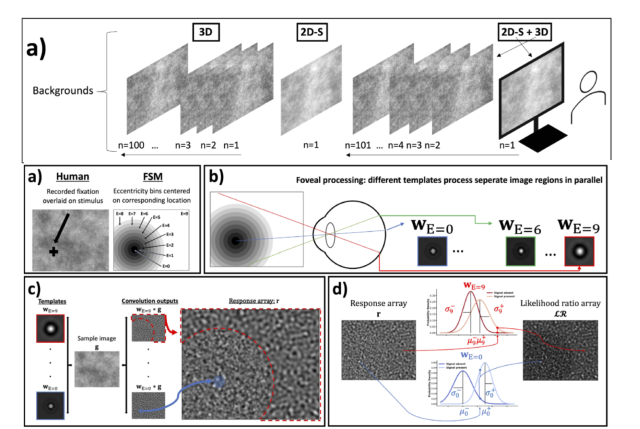New paper by Devi Klein explains when and why 2D synthesized images aid search with 3D image stacks
Why do radiologists rely on 2D synthesized images to complement their search through 3D image stacks?

Devi Klein has published a new paper in IEEE Transactions in Medical Imaging that gains a scientific understanding of why radiologists often rely on a complementary 2D synthesized image (2D-S, often referred to as C-View for Hologic systems in Digital Breast Tomosynthesis) when scrutinizing a 3D image stack for cancer. In his paper, Devi conducts a study with trained observers and records their eye movements as they search 3D image stacks, or 3D image stacks complemented with the 2D-S synthesized image. The study finds that with the combination of 3D and 2D synthesized images observers improve their localization and detection of the small (but not large) signals compared to 3D alone. The finding is explained by the lower spatial acuity in the observers’ visual periphery (vision away from the point of fixation) hinders the search for the small signals in the 3D images. Devi analyzes the eye movement data of the observers to show how the inclusion of the 2D-S guides eye movements to suspicious locations, improving the observer’s ability to find the signals in 3D. To understand this process at a computational level, he implemented a Foveated Search Model (FSM) that executes human eye movements and then processes points in the image with varying spatial detail based on their eccentricity from fixations. The FSM predicts human performance for both signals and captures the reduction in search errors when the 2D-S supplements the 3D search. Our experimental and modeling results delineate the utility of 2D-S in 3D search—reduce the detrimental impact of low-resolution peripheral processing by guiding attention to regions of interest, effectively reducing errors. Together, Devi's paper brings a scientific understanding as to why 2D-synthesized images help radiologists detect cancer in 3D and how these benefits are the greatest for small signals.
Published in: IEEE Transactions on Medical Imaging ( Volume: 42, Issue: 8, August 2023)